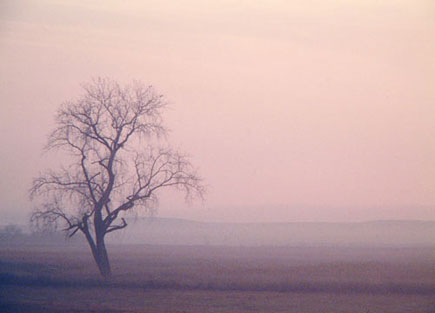Thoughts on Color Balance
Digital and Film
 |
|
|
|
 |
|
|
In practical terms, color balance is how a subject is changed by the light source under which it is photographed. When color is in "balance" we see the subject as we remember it--a banana records as yellow, a shirt as white, a person's skin tone is true. If the banana records as red, if a white shirt records as yellow, or if a person's skin tone is purple, we say that the color rendition is out of balance and that some corrective measures have to be made. Of course, color does add mood, and always having neutral or true color in an image is not always desired. But in its purest sense color balance is using adjustments, filters or image processing to make up for the difference between our adaptive eye and the way film or a digital imaging sensor "sees" color.
Films are manufactured with a certain color balance, which means they will
record true color under certain lighting conditions. In film, "daylight"
color balance (about 5500 degrees Kelvin) is the most common. But if that film
is exposed under other lighting conditions that color will not be true. For
example, if a daylight-balanced film is exposed in a room lit by incandescent
bulbs the image will record with an amber cast. This occurs because the light
source is deficient in blue and the film "expects" the blue. Its
absence causes the recorded scene to have a color bias, or imbalance.
Our eyes do not see this deficiency, as we adapt to the light source. Film "sees"
color as if everything were illuminated by daylight (or "white"
light, with the full spectrum included.) There are classes of films with tungsten
balance (either 3400 or 3200K) that can be used under artificial continuous
light, but it's more common practice to use color-balancing filters over
the lens to correct the color in the image. To an extent, minor color balance
problems can be used when the film image is printed, but major color shifts
are difficult to correct.
The most accurate method of getting true color under a variety of light sources with film is to use a color temperature meter that recommends color-correcting filters over the lens, but this practice is usually limited to professional studio photographers and cinematographers.
Films may have a certain color bias built in. This is obvious when working
with slide films, where overall color can range from "cool" (slight
blue bias) to neutral (little bias) to "warm" (slight yellow bias.)
In addition, films are made to yield more or less color saturation, and range
from slight to sometimes heavy-handed color richness. Color print film can also
range in similar fashion, but in truth the color is often more affected by the
lab that makes the prints.
Digital cameras eliminate all this bother about color through a processing step
known as white balance. The sensor itself does not do this; it is either programmed
into the on-board image processor before exposure or fixed in the computer later.
Setting a certain white balance (of which there are usually five or six available)
will place the processing system within a range of corrective white balance
settings.
 |
|
|
|
 |
|
|
|
 |
|
|
By playing with the white balance controls you can alter the color "mood" of an image, much like placing color filters over the lens when you shoot film. Here, this lone tree outside Sacramento, CA, is photographed with no white balance adjustment, a "cloudy" setting (which gives added warmth) and a "tungsten" white balance setting, which gives a magenta cast. You can use white balance settings in the camera or, if you shoot Raw, change them with ease in your Raw converter software later.
Custom white balance controls allow the photographer to be more precise, if desired, and to set the color balance for a very specific light source. This acts like a color temperature meter without the need to add color-correcting filters over the lens. In addition, color moods can be enhanced by using white balance as a color enhancer and to add a touch of warmth (using "cloudy" white balance) or cool blue (using tungsten white balance) to the image. Digital cameras and computer imaging techniques literally eliminate the need for filters or changing film for proper color balance.
In addition, programming in the digital camera or later can also modify color saturation. This modification need not be "global"--affecting the entire image as with film--but can be selectively applied to each color as desired.
The whole debate about a film's "personality" is made moot by digital photography. It's not a matter of recording neutral color or even well balanced color images--it's more that you can use image processing to emulate every film "personality" available now, in the past or in the future. Using white balance, color saturation and even contrast controls, the digital image is totally flexible and malleable when it comes to color control.
- Log in or register to post comments












































